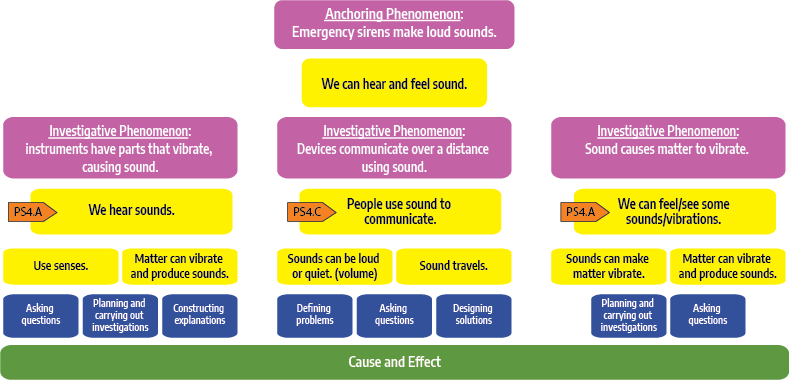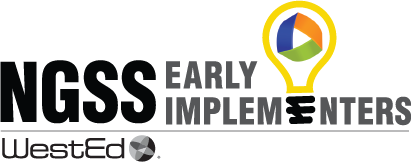
After completing this unit, students will never look at an ambulance or police car the same way again. The anchoring phenomenon for this unit is “Emergency sirens make loud sounds.” This unit would be part of a Physical Science unit on Sound and Light. In this unit, students identify that sounds cause vibrations and vibrations cause sound, and that sound is used to communicate over distance. While walking the playground, students observe the sounds that they hear around them. They then conduct investigations into how sound is made and explore the cause and effect relationship between sounds and vibrations. Students will also design devices that use sound to communicate over a distance.
EXAMPLE: Students observe a tabletop siren. They identify the use of sound to communicate and describe how sound and vibrations are related to one another.
The Performance Expectations (PEs) addressed in this unit are:
| 1-PS4-1 | Plan and conduct investigations to provide evidence that vibrating materials can make sound and that sound can make materials vibrate. |
|---|---|
| K-2-ETS1-1 | Ask questions, make observations, and gather information about a situation people want to change to define a simple problem that can be solved through the development of a new or improved object or tool. |

The Learning Sequence Narrative briefly describes what students do in each lesson and links the learning between the lessons as a conceptual storyline. At the end of each learning sequence, students make connections to their understanding of the investigative phenomenon (and to the anchoring phenomenon if appropriate).
The anchoring phenomenon for the learning sequence is, “Emergency sirens make loud sounds.” The investigative phenomena for the learning sequence are as follows:
Students figure out this phenomenon by:
Asking Questions and Defining Problems
Asking questions and defining problems in K–2 builds on prior experiences and progresses to simple descriptive questions that can be tested.
Planning and Carrying Out Investigations
Planning and carrying out investigations to answer questions or test solutions to problems in K–2 builds on prior experiences and progresses to simple investigations, based on fair tests, which provide data to support explanations or design solutions.
Constructing Explanations and Designing Solutions
Constructing explanations and designing solutions in K–2 builds on prior experiences and progresses to the use of evidence and ideas in constructing evidence-based accounts of natural phenomenon and designing solutions.
PS4.A: Wave Properties
PS4.C: Information Technologies and Instrumentation
ETS1.A: Defining and Delimiting Engineering Problems
Cause and Effect
The following Learning Sequence Narrative is based on the conceptual flow concept map above.
This is the first lesson out of a sequence of three. The lesson begins by connecting to the fact that kids hear sounds all day, every day by going on a sense walk and generating a list of things observed, specifically focusing on sounds heard. The anchoring phenomenon, “Emergency sirens make loud sounds,” is introduced in this lesson as one of the sounds that we hear or have heard before. The challenge of engineering a pretend siren for an ambulance that has a broken siren is introduced as the unifying event.
Students are encouraged to ask questions and to determine which ones can be investigated. Students will need support with the practice of asking questions, especially ones that can be investigated, as they usually do not have experience with this concept. Teachers can provide modified levels of support to students depending on their experience and language needs. The focus is on “What causes sound.”
As the lesson progresses, students are challenged to use materials at given stations to make sound and figure out what the cause of that sound is. During this time, you will model how to plan and carry out an investigation. The large take-away at the end of the lesson is that vibrating matter makes sound. This idea is built up during the next lesson, where students are challenged to construct devices that make loud sounds as a form of communication.
In the previous lesson, students identified that they hear many different sounds. Then they planned and carried out an investigation to try to figure out what causes sound. They used a variety of instruments to find that vibrating material causes sound. This lesson further develops this concept by having students apply their incipient knowledge about what causes sound to solve a challenge and create a device to communicate over a distance. The next lesson will have students investigate how sound causes vibrations.
This is the third lesson in the learning sequence. In the two previous lessons, students explored the idea that vibrations cause sound. They have also used sound to communicate over a distance. In this lesson, the students explore the phenomenon that sound causes matter to vibrate, which completes the cause and effect relationship between sound and vibrations. They investigate vibrations using a drum and a tuning fork and draw a group model that explains the cause and effect relationship between sound and vibration.
Differentiated student support strategies offer teachers a way to meet all students’ needs. The classroom brings together students from different backgrounds with varying degrees of science knowledge. Being an effective teacher, therefore, requires the implementation of creative and innovative teaching strategies in order to meet students’ individual needs.
Throughout these lessons, a flag ( ) denotes formative assessment opportunities where you may change instruction in response to students’ level of understanding and making sense of phenomena. Below are some strategies you might implement based on those assessments. There is no one strategy that works best for every teacher, so try different strategies to determine which are best for you and your students.
) denotes formative assessment opportunities where you may change instruction in response to students’ level of understanding and making sense of phenomena. Below are some strategies you might implement based on those assessments. There is no one strategy that works best for every teacher, so try different strategies to determine which are best for you and your students.
Suggested strategies for students who have not met the targeted expectations:
When I <cause>, I notice <effect>.
If I want <effect>, I need to <cause>.
I wonder what the effect would be if ___.
I think ___ is causing ___.
Suggested strategies for students who have met the targeted expectations:
Science Talks will be used throughout these lessons. Below is background information and strategies to use with students.
Scaffolding the Science Talk
Small group discussion (pairs, groups) should always precede large group discussion to activate thinking and maximize the likelihood of thoughtful responses in the large group. Small group discussion can serve as a scaffold for English Learners or others less inclined to speak in a large group.
Revisit Classroom Norms
Many teachers explicitly teach (through mini lessons) and practice conversation norms prior to launching their first Science Talk. As always, your focus will vary, based on the strengths and challenges of your class.
Characteristics of Science Talks
Making Meaning Science Talk
Purpose: To draw conclusions, explain phenomenon, and raise additional questions
Teacher’s Role in Making Meaning Science Talk
Student Conversation Moves
Some teachers co-develop and post helpful prompts or sentence frames.
Examples:
Teacher Prompts or Probes
*Addressing Student Misunderstandings. Many teachers hold off on correcting misunderstandings until after the Science Talk, though they will probe students for further evidence in the moment. In this way, teachers and students value the knowledge constructed through the discussion itself, rather than looking for the teacher to provide the correct answer.
Considerations for Planning a Science Talk
Rocío García: First Grade Bilingual Teacher, Tracy Unified SD Nicole Hawke: First Grade Teacher, Coachella Valley Unified SD Crystal Howe: TK-12 Science Resource, San Diego Unified SD Claudio Vargas: Educational Consultant, Sci-Lingual Education
Sharon Schmidt, First Grade Teacher, San Diego Unified SD Michelle Armenta, First Grade Teacher, Vista Unified SD
Science Peer Review Panel

A Collaboration of the K-12 Alliance @ WestEd, Aspire Public Schools, Galt JUSD, High Tech High, Kings Canyon USD, Lakeside USD, Oakland USD, Palm Springs USD, San Diego USD, Tracy USD, Vista USD, Achieve, and the California Department of Education
with funding from the S.D. Bechtel, Jr. Foundation and Hastings-Quillin Fund
The California K–8 NGSS Early Implementation Initiative, developed by the K–12 Alliance at WestEd with close collaborative input on its design and objectives from the State Board of Education, the California Department of Education, and Achieve is a fast-start demonstration project to build local education agency (LEA) capacity to fully implement the Next Generation Science Standards (NGSS) as a core subject in the elementary grades (K–5) and as the SBE’s preferred integrated model in grades 6–8.
The four-year Initiative provides teachers and administrators with in-depth, content-rich professional development to build leadership capacity and teacher acumen to deliver high-quality 3-dimensional learning for K–8 students. In addition, through collaborations among the K–12 Alliance, Achieve, and others, the LEAs in the Collaborative have opportunities to pilot test new NGSS-aligned tools, processes, assessment item prototypes, and digital and other instructional materials. The LEAs serve as resources for NGSS implementation across California, and in other NGSS-adopting states as well.
This resource presents the conceptual storyline for a unit of instruction at a specific grade level, then focuses on a portion of the storyline called a learning sequence. The learning sequence uses the three dimensions of the NGSS (disciplinary core ideas–DCI; science and engineering practices–SEP; and crosscutting concepts–CCC) to build and deepen student understanding of natural phenomena and design challenges.
Participants in the CA NGSS K–8 Early Implementation Initiative developed and field-tested the lessons in the learning sequence. The sequences were vetted by the Science Peer Review Panel using Achieve’s EQuiP rubric for science and found to be aligned with the intent of the NGSS.
Community Resources for Science (CRS). “Science Talks” Accessed October 22, 2019. http://www.crscience.org/pdf/Science.Talk.Structures.pdf
NGSS Lead States. 2013. Next Generation Science Standards: For States, By States. Washington, DC: The National Academies Press.